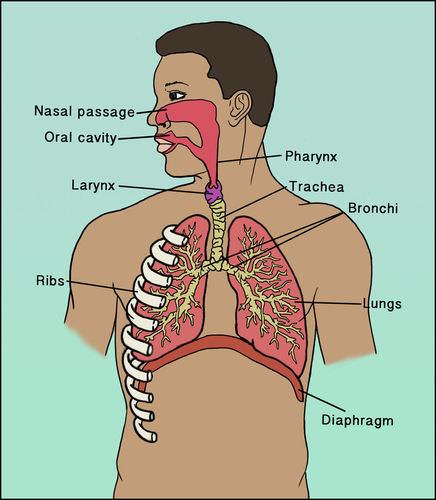3.3呼吸系统
章节大纲
-
Lesson Objectives
::经验教训目标- Define respiration.
::定义呼吸。
- Identify structures of the respiratory system.
::查明呼吸系统的结构。
- Explain breathing mechanisms.
::解释呼吸机制。
Lesson Vocabulary
::词汇表课程- lung
::肺
- respiration
::重新呼吸
- respiratory system
::呼吸道系统
Introduction
::导言You just got done with a long run. You are gasping for air. Why does your body react this way? What is the purpose of breathing?
::你刚刚做了一个长期的。你正在喘气。为什么你的身体会这样反应?呼吸的目的是什么?All the cells of your body need oxygen to work properly. Your body's circulatory system works with the respiratory system to deliver the oxygen. Your blood carries red blood cells. The main job of red blood cells is to carry oxygen throughout your body. The red blood cells get oxygen in the lungs. The lungs are the main organs of the respiratory system. The respiratory system is the body system that takes in oxygen. It then releases carbon dioxide back to the atmosphere. The carbon dioxide is the waste material from the cells.
::你身体的所有细胞都需要氧气才能正常工作。你身体的循环系统与呼吸系统合作,以提供氧气。你的血液携带红血细胞。红血细胞的主要工作是携带氧气。红血细胞在肺部中获取氧气。肺部是呼吸系统的主要器官。呼吸系统是吸收氧气的身体系统。然后将二氧化碳释放到大气中。二氧化碳是细胞中的废物。What Is Respiration?
::什么是呼吸?Respiration is the exchange of oxygen with carbon dioxide. This process consists of two stages. In one stage, air is taken into the body. Carbon dioxide is then released to the outside air. In the other stage, oxygen is delivered to all the cells of the body. Carbon dioxide is carried away from the cells. Oxygen and carbon dioxide are the two gases exchanged through respiration.
::呼吸是氧与二氧化碳的交换。 这个过程由两个阶段组成。 在一个阶段, 空气被吸收到身体中。 然后二氧化碳被释放到外部空气中。 在另一个阶段, 氧被输送到身体的所有细胞中。 二氧化碳被从细胞中吸收。 氧和二氧化碳是两种通过呼吸交换的气体。Structures of the Respiratory System
::呼吸系统的结构You can see the main structures of the respiratory system in Figure . They include the nose, trachea, lungs, and diaphragm. Use the figure to trace how air moves through the respiratory system.
::您可以在图中看到呼吸系统的主要结构。 它们包括鼻子、气管、肺和隔膜。 使用该图来追踪空气如何通过呼吸系统。Structures of the respiratory system Steps in Respiration
::呼吸步骤Take in a big breath of air through your nose. As you breathe in, you may feel the air pass down through your throat. Your chest expands. Now breathe out and observe the opposite events occurring. Breathing in and out may seem like simple actions. They are just one part of a complex process. Respiration actually occurs in four steps:
::用鼻子吸气。 吸气时, 你可能会感觉到空气通过喉咙。 你的胸部会膨胀。 现在呼吸并观察相反的事件发生。 呼吸和呼气可能看起来就像简单的动作。 它们只是复杂过程的一部分。 呼吸实际上分四步进行:- breathing (inhaling and exhaling)
:吸入和呼气)
- gas exchange between the air and blood
::空气与血液之间气体交换
- gas transport by the blood
::血液输送气体
- gas exchange between the blood and cells
::血液和细胞之间交换气体
Note: gas exchange refers to the exchange of oxygen and carbon dioxide.Breathing
::呼吸呼吸Breathing is the process of moving air into and out of the lungs. The process depends on a muscle called the diaphragm. This is a large, sheet-like muscle below the lungs.
::呼吸是将空气流进和流出肺的过程。这一过程取决于一个称为隔膜的肌肉。这是肺下一个大块的、像板状的肌肉。- Inhaling, or breathing in, occurs when the diaphragm muscle tightens. This increases the size of the chest. This too decreases air pressure inside the lungs. This action allows air and gases to enter the lungs.
::当隔膜肌肉收紧时,吸入或呼吸就会发生。这会增加胸部的大小。这也会降低肺部的空气压力。这样可以让空气和气体进入肺部。
- Exhaling, or breathing out, occurs when the diaphragm muscle relaxes. This decreases the size of the chest. This increases air pressure inside the lungs. This action allows for air to leave the lungs.
::当隔膜肌肉放松时,就会呼气或呼气。这样会降低胸部的大小。这会增加肺部的空气压力。这样可以让空气离开肺部。
When you inhale, air enters the respiratory system through your nose and ends up in your lungs, where gas exchange with the blood takes place. What happens to the air along the way?
::当你吸入时,空气通过鼻子进入呼吸系统,最后进入肺部,与血液发生气体交换。路上的空气会怎么样?- In the nose, mucus and hairs trap any dust or other particles in the air. The air is also warmed and moistened.
::在鼻子、肌肉和毛发中,空气中存在任何尘埃或其他微粒,空气也变暖和湿润。
- Next, air passes through a passageway that is connected to the windpipe.
::接下来,空气通过一个通向风管的通道
- The air then finds its way to the lungs.
::空气会进入肺部
- In the chest, the windpipe splits so that air enters both the right and left lung. These passages are covered with mucus and tiny hairs called cilia. The mucus traps any remaining particles in the air. The cilia move and sweep the particles and mucus toward the throat so they can be expelled from the body.
::在胸腔中,风管破裂,空气进入了左、右肺。这些通道被粘住了粘膜和微小的毛发,叫做仙利亚。黏液将空气中的任何剩余微粒都困住。仙人掌向喉咙移动并扫扫扫微粒和粘结,这样它们就可以被从身体中赶走。
Gas Exchange Between Air and Blood
::空气和血液之间的气体交换Within the lungs there are thin pockets. It is in these thin pockets that gases are exchanged between the lungs and the blood. Here, oxygen enters red blood cells and carbon dioxide leaves the red blood cells.
::肺部有薄口袋。正是在这些薄口袋中,肺部和血液之间交换气体。这里,氧气进入红血细胞,二氧化碳离开红血细胞。Gas Transport in the Blood
::输气输血Once red blood cells are rich in oxygen, they leave the lungs. They travel through the heart. The heart pumps the oxygen-rich blood into arteries. The arteries carry the oxygen-rich blood throughout the body.
::红血细胞一旦富含氧气,就会离开肺部,穿透心脏,心脏将富含氧的血液抽进动脉,动脉将富含氧的血液带入全身。Gas Exchange Between the Blood and Cells
::血液和细胞间气体交换Once red blood cells reach the cells, they exchange the oxygen for carbon dioxide wastes. The carbon dioxide travels back to the lungs. The carbon dioxide is then passed into the lungs where it is exhaled out of the body.
::一旦红血细胞到达细胞,它们就会用氧气交换二氧化碳废物。二氧化碳会回流到肺部。然后二氧化碳就会传到肺部,从体内吐出。Every time you breathe in and out your body is exchanging gases. Each time you breathe in you take in oxygen. Each time you breathe out you get rid of carbon dioxide. Breathing allows for the continuous process of exchanging these gases.
::每次你呼吸和呼吸的时候,你的身体都在交换气体。每次你吸氧的时候,你吸氧的时候,每次呼吸的时候,你就会摆脱二氧化碳。呼吸可以让这些气体不断的交换过程。Lesson Summary
::经验教训摘要- The respiratory system is the body system that exchanges gases with the outside air. It brings air containing oxygen into the body for the cells. It also releases carbon dioxide from the cells into the air. This exchange of gases is called respiration.
::呼吸系统是用外部空气交换气体的机体系统,它将含有氧气的空气带入细胞的身体,还将二氧化碳从细胞中释放到空气中。这种气体的交换称为呼吸。
- Breathing is the process of moving air into and out of the lungs. It depends on the muscle called the diaphragm.
::呼吸是将空气流进和流出肺的过程,取决于肌肉,即隔膜。
- The lungs are the main organs of the respiratory system. This is where gases are exchanged between the air and the blood. Gases are also carried by the blood throughout your body. The blood carries back the waste gases from your cells so they can be exhaled through your lungs.
::肺部是呼吸系统的主要器官。 这是空气和血液之间交换气体的地方。 气体也由全身的血液携带。 血液从细胞中取回废气, 以便通过肺中呼吸。
Lesson Review Questions
::经验回顾问题Recall
::回顾- What is the function of the respiratory system?
::呼吸系统的作用是什么?
- List steps in the process of respiration.
::列出呼吸过程中的步骤。
Apply Concepts- Why do you think you need to breathe heavily after exercise?
::为什么你觉得锻炼后需要深呼吸?
Think Critically
::仔细仔细思考- Explain how the diaphragm controls breathing.
::解释隔膜如何控制呼吸
- Define respiration.
